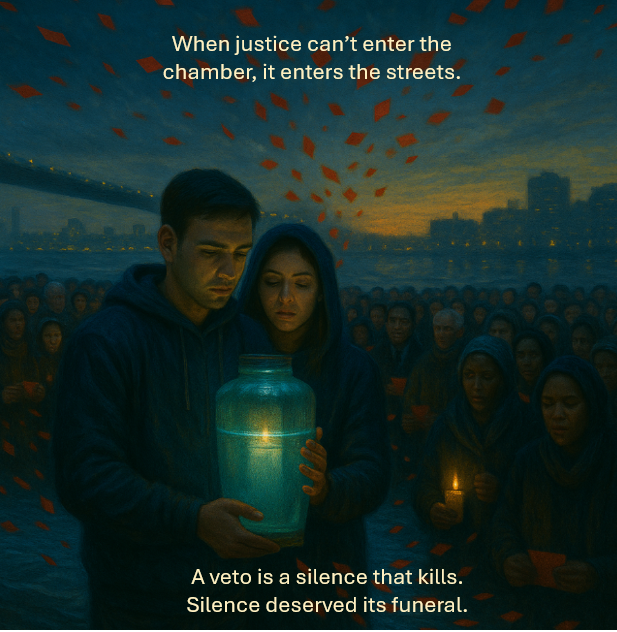
Date: January 27, 2028
Location: First Avenue, UN Headquarters → East River
Occasion: A Global Mourning Ritual
It began with paper.
Not speeches.
Not resolutions.
Just paper—
thin bright squares of red, the color of dried ink, flame, and finality.
By sunrise, thousands of people were gathered outside the UN Headquarters holding them. Children folded them into petals, parents tore them into strips, teenagers crumpled and uncrumpled them like nervous prayers.
All waiting for something they had never seen before:
The funeral of a power, not a person.
The Red Tide
The streets surrounding the UN turned red.
Every sidewalk.
Every staircase.
Every fence.
Every railing.
Red squares of paper taped, pinned, tied, or simply held by numb bare fingers in the cold January air.
News anchors whispered into their microphones:
“Today the world is burying the veto.”
Some governments condemned the gathering.
Some tried to ignore it.
None could stop it.
The crowd was too large, too quiet, too determined.
No slogans.
No chants.
Only breath clouds rising in the freezing morning light.
The Circle Arrives
When the Circle walked through the crowd,
people stepped aside as if making way for pallbearers.
Emil carried a transparent urn—a cylindrical glass vessel nearly three feet tall, its base etched with the spiral from the Security Council table.
Inside the urn:
nothing yet.
Just emptiness waiting for history.
Layla held a stack of small tags, each printed with the words:
“Let it go.”
Priya followed with LED strips coiled around her wrists, ready to illuminate the procession after sunset.
Sami clutched a fistful of chalk dust in his mittens.
Aisha’s hands were trembling.
The Secretary-General’s Remark
Secretary-General Amara Okonkwo stood at the plaza entrance, flanked by two guards who were not guarding her, but the crowd—keeping space, not restricting it.
She wore no scarf today, no formal coat, no diplomatic badge.
Only a simple black shawl.
“The veto is not dead,” she said to the Circle as they approached.
Emil swallowed. “Not yet.”
She placed a single red square into his hand.
“Then I will help kill it.”
The Ceremony Begins
At 10:04 a.m., bells rang from somewhere—nobody could identify from which building.
But everyone heard them.
The crowd fell completely silent.
Emil lifted the urn.
Layla stepped forward and spoke the only scripted line of the day:
“If a stamp can silence nations,
then people can silence the stamp.”
She placed the first red square inside the urn.
Others followed.
Delegates.
Interns.
Security guards.
Students.
Tourists.
Displaced families.
Mothers.
Veterans.
Homeless neighbors from Midtown.
Diplomats who snuck out between meetings.
A judge from the International Court of Justice.
A man whose wife had died in an airstrike.
A girl whose village had been swallowed by sea level rise.
One by one, they placed red squares into the urn until it glowed like a lantern filled with embers.
The Speeches That Were Not Speeches
No podium was used.
Instead, people stepped forward to share one sentence each, never more.
A refugee from Sudan:
“I was collateral. No more.”
A Japanese schoolteacher:
“A veto is a silence that kills.”
A Colombian grandmother:
“My grandson’s breath was not a vote for war.”
A Palestinian nurse:
“My patients die while nations argue.”
A young Russian conscript, shaking:
“I want to live in a world where I never have to fight again.”
A diplomat from Finland:
“We have buried enough people. It is time to bury the tools that bury them.”
Their words hung in the cold like crystal wings.
The Procession to the River
At dusk, the urn was sealed.
Priya activated the LED ribbons, bathing the urn in a slow, pulsing teal—
the color of breath, of possibility.
The crowd followed as the Circle led the procession eastward toward the river.
Police blocked traffic without being asked.
Store owners came out and placed candles on windowsills.
Construction workers lowered their helmets.
The procession was not angry.
It was grieving.
And grief, when shared, becomes direction.
The Burial
At the riverbank, Emil and Layla waded knee-deep into the freezing water.
Security tried to stop them.
The Secretary-General raised her hand.
“Let them finish.”
Emil lowered the urn into the river.
Water surged around it.
He whispered:
“For every life dismissed as collateral damage.”
Layla whispered:
“For every breath that never reached the table.”
They released the urn.
LED ribbons flickered softly.
The urn drifted outward, glowing like a floating lighthouse of grief.
People removed their red squares from their pockets, tore them into tiny pieces, and let the wind take them.
A red snowfall over the East River.
A global release.
The Moment the Wind Shifted
When the urn passed beneath the shadow of the FDR overpass,
a sudden gust of wind lifted the remaining red fragments swirling above the crowd.
In that instant,
every phone, drone, and camera captured it:
The red fragments rose into the air
in a spiral—
almost identical to the one burned into the Security Council table.
But this spiral was made not of ash,
but of release.
The crowd gasped.
Some wept.
Sami whispered:
“It’s breathing.”
The Funeral Ends with No Applause
Because funerals are not victories.
They are turning points.
As night settled over the city, the river carried the glowing urn southward—
toward the harbor,
toward the ocean,
toward every shore that had ever suffered under the false neutrality of veto power.
The next morning, newspapers around the world carried the same headline:
THE VETO IS DEAD.
THE PEOPLE BURIED IT.
But Emil knew the truth:
The funeral was not the end.
It was the invitation.
Tomorrow would not be about mourning.
Tomorrow would be about building the world that comes after flags.

